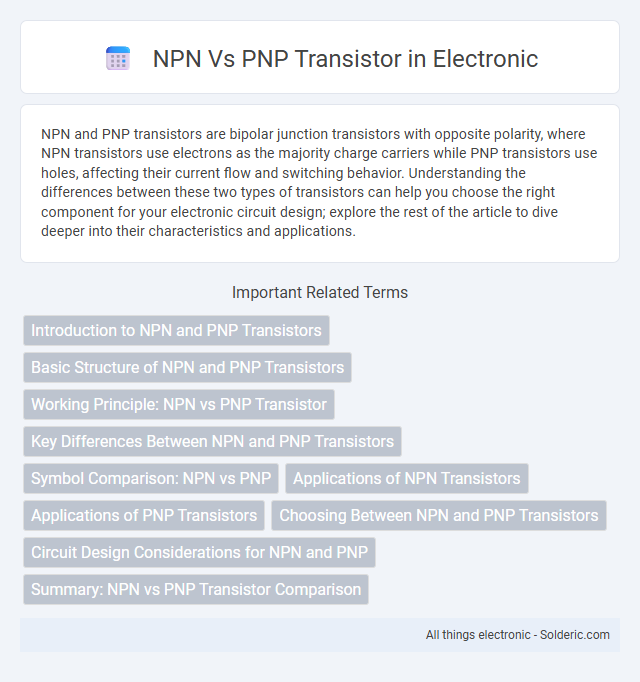NPN and PNP transistors are bipolar junction transistors with opposite polarity, where NPN transistors use electrons as the majority charge carriers while PNP transistors use holes, affecting their current flow and switching behavior. Understanding the differences between these two types of transistors can help you choose the right component for your electronic circuit design; explore the rest of the article to dive deeper into their characteristics and applications.
Comparison Table
| Feature | NPN Transistor | PNP Transistor |
|---|---|---|
| Current Flow | Electrons flow from emitter to collector | Holes flow from emitter to collector |
| Biasing | Base-emitter junction forward biased, base-collector reverse biased | Base-emitter junction forward biased, base-collector reverse biased (with opposite polarity) |
| Symbol | Arrow pointing out of the emitter | Arrow pointing into the emitter |
| Application | Common in low-side switch circuits | Common in high-side switch circuits |
| Voltage Polarities | Collector positive relative to emitter | Emitter positive relative to collector |
| Majority Charge Carrier | Electrons | Holes |
Introduction to NPN and PNP Transistors
NPN and PNP transistors are fundamental types of bipolar junction transistors (BJTs) used to amplify or switch electronic signals. NPN transistors have a layer of P-type semiconductor sandwiched between two N-type layers, while PNP transistors consist of an N-type layer between two P-type layers. Understanding the difference between NPN and PNP transistors helps you select the right component for your circuit design, as their operating polarities and current flows differ significantly.
Basic Structure of NPN and PNP Transistors
NPN transistors consist of two n-type semiconductor layers separated by a thin p-type layer, while PNP transistors feature two p-type layers with an n-type layer in between. The emitter in an NPN transistor emits electrons into the base, which is lightly doped and thin, allowing efficient current flow when forward biased. In contrast, the PNP transistor's emitter injects holes into the base, with current flow occurring due to hole movement across the junctions under proper biasing conditions.
Working Principle: NPN vs PNP Transistor
NPN transistors work by allowing current to flow from the collector to the emitter when a positive voltage is applied to the base, using electrons as the majority charge carriers. PNP transistors operate by allowing current to flow from the emitter to the collector when a negative voltage is applied to the base, with holes serving as the primary charge carriers. Understanding the difference in working principles helps you select the appropriate transistor type for your circuit's voltage and current requirements.
Key Differences Between NPN and PNP Transistors
NPN transistors have electrons as majority carriers, making them faster and more efficient in switching applications, while PNP transistors use holes as majority carriers, typically found in low-side switching circuits. The current flow in NPN transistors is from the collector to the emitter, whereas in PNP transistors, it flows from the emitter to the collector. Understanding these key differences helps you select the right transistor type for your electronic circuit design.
Symbol Comparison: NPN vs PNP
The NPN transistor symbol features an arrow on the emitter leg pointing outward, indicating electron flow from the emitter to the base, while the PNP transistor symbol has the arrow pointing inward toward the base, representing hole flow from the emitter to the base. This directional arrow in the symbol clearly differentiates the current flow and polarity between NPN and PNP transistors. Understanding these symbol distinctions is crucial for correctly interpreting circuit diagrams and ensuring proper transistor orientation in electronic designs.
Applications of NPN Transistors
NPN transistors are widely used in switching applications and amplification circuits due to their ability to efficiently control current flow with electron majority carriers. They are commonly found in power amplifiers, signal processing devices, and digital logic circuits, where swift switching and high gain are essential. Their compatibility with positive power supplies makes them the preferred choice in most modern electronic devices and microcontroller interfacing.
Applications of PNP Transistors
PNP transistors are commonly used in switching applications where the load is connected to the positive voltage supply, allowing current to flow from the emitter to the collector when activated. Your circuits benefit from PNP transistors in high-side switches, amplifying signals in low-side negative voltage configurations, and driving loads in analog and digital systems. These transistors excel in controlling current flow within power management and automotive electronics due to their ability to source current efficiently.
Choosing Between NPN and PNP Transistors
Choosing between NPN and PNP transistors depends largely on the circuit configuration and voltage polarity; NPN transistors are preferred for low-side switching with the emitter connected to ground, allowing easier drive with positive voltages. PNP transistors are typically used for high-side switching with the emitter connected to a positive voltage supply, enabling control when the load is connected to ground. Understanding the polarity requirements and switching position in the circuit optimizes transistor selection for efficient current flow and signal amplification.
Circuit Design Considerations for NPN and PNP
NPN transistors are preferred in circuit designs requiring a common ground reference as they source current from the collector to the emitter when activated by a positive base voltage. PNP transistors conduct when their base is driven below the emitter voltage, making them ideal for high-side switching applications in your circuits. Understanding the polarity and current flow direction is crucial for optimizing performance and ensuring reliable operation in NPN and PNP transistor-based designs.
Summary: NPN vs PNP Transistor Comparison
NPN transistors conduct when a positive voltage is applied to the base relative to the emitter, making them ideal for low-side switching, while PNP transistors conduct when the base is at a lower voltage than the emitter, suitable for high-side switching. The electron flow in NPN transistors moves from the emitter to the collector, whereas in PNP transistors, hole flow travels from the emitter to the collector. Understanding these key differences helps you select the proper transistor type for your circuit design and switching requirements.
NPN vs PNP transistor Infographic

 solderic.com
solderic.com